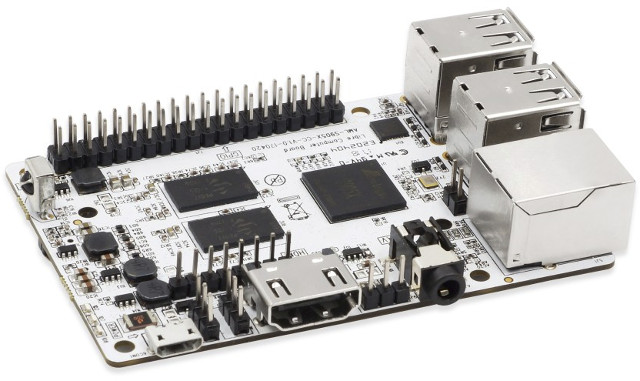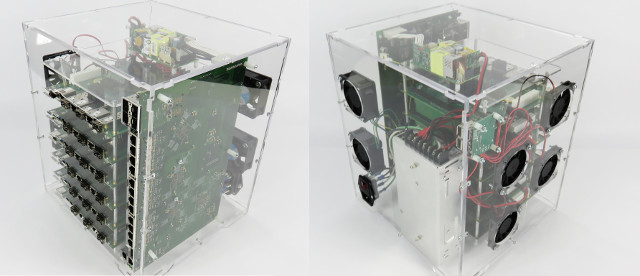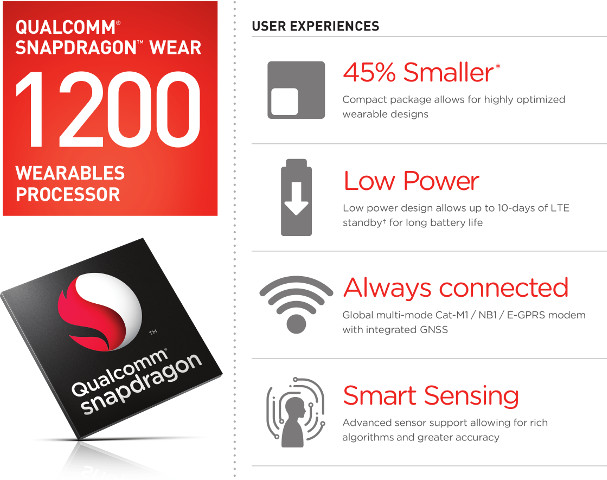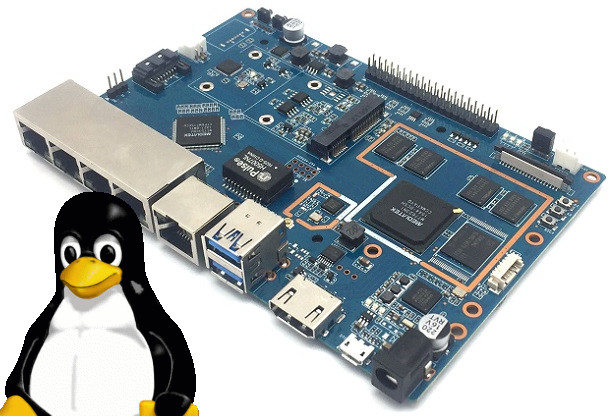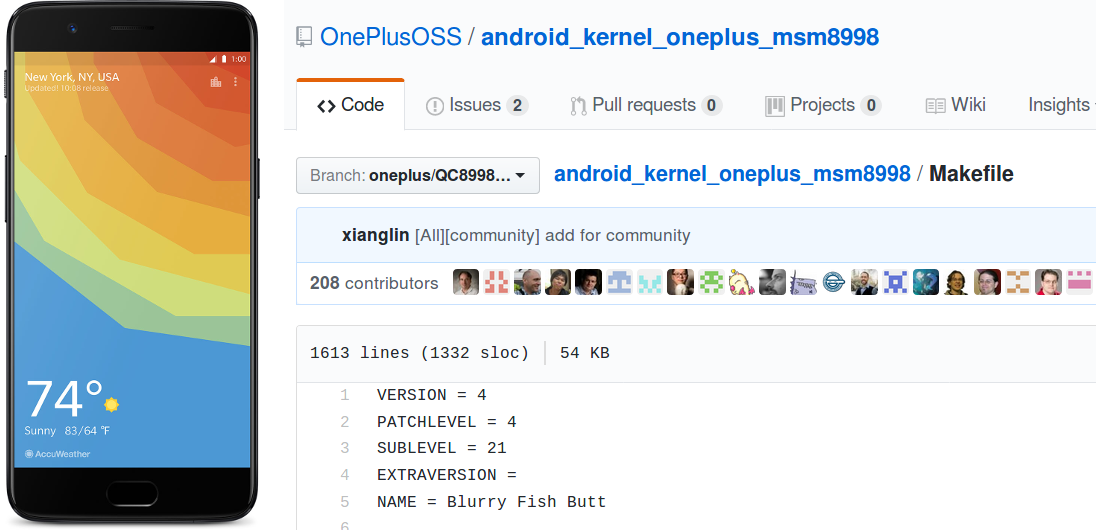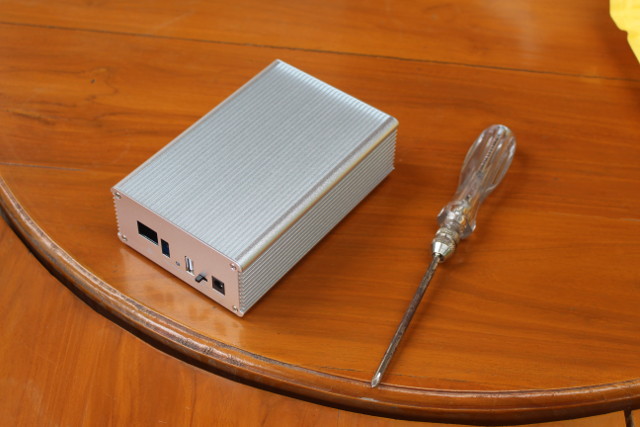Up to now there were two notable Amlogic S905(X) development boards: ODROID-C2 and Khadas Vim. Shenzhen Libre Technology Co., Ltd, a Shenzhen startup, is about to bring one more to the market with Le Potato board, aka AML-S905X-CC, powered by Amlogic S905X processor with 1 or 2 GB RAM, and in a form factor similar to the Raspberry Pi 3 board. Le Potato /AML-S905X-CC board specifications: SoC – Amlogic S905X quad core ARM Cortex-A53 processor @ 1.5 GHz with penta core ARM Mali-450MP GPU, and Amlogic Video Engine 10 System Memory – 1GB or 2GB DDR3 RAM Storage – 1x micro SD Card slot with UHS SDR104 support, eMMC module connector with HS400 support Video Output – HDMI 2.0 Port, 3.5mm TRRS “AV” jack with CVBS (480i / 576i) Audio Output – HDMI, AV jack (stereo audio), SPDIF output header, and I2S header Connectivity – 10/100M Ethernet USB – 4x […]
NFV PicoPod is a Cluster of Six MACCHIATOBin Networking Boards for OPNFV, ODP, DPDK and OPF
If you are interested in networking applications, you may have already heard about Marvell ARMADA 8040 based SolidRun MACCHIATOBin board with multiple 10Gbps and Gbps network interfaces, three SATA ports, and more. PicoCluster has decided to make a cluster of 6 MACHIATOBin boards coupled with a Marvell Prestera DX 14 port, 10GbE switch for OpenDataPlane (ODP), Data Plane Development Kit (DPDK), OpenFastPath(OPF) as well as OPNFV (Open Platform for Network Functions Virtualization) . The main features of the full assembled kit – named Cube – include: 6x MACCHIATOBin quad core Cortex A72 boards (24 cores in total) 1x Prestera DX 10GbE 14-port switch board 6x fans Power Supply Acrylic case The cluster kit comes with 64GB micro SD cards pre-loaded with the latest OPNFV Danube software release for ARM integrated by ENEA Software AB. The cluster is said to be compliant with the OPNFV Pharos specification. Three pre-order options are […]
Qualcomm Snapdragon Wear 1200 Platform for Wearables Supports LTE Cat M1 and NB1 (NB-IoT)
After Snapdragon Wear 2100 and 1100 launched last year , Qualcomm has announced a new Snapdragon Wear 1200 platform still designed for wearables, but with lower power consumption, less processing power, a more compact package, and built-in support for LTE IoT communications standards such as LTE Cat M1 and LTE NB-IoT (Cat NB1). Qualcomm Snapdragon Wear 1200 key features and specifications: CPU – ARM Cortex A7 @ 1.3 GHz Memory / Storage – Support for discreet or MCP NAND and LPDDR2 Display – Support via SPI for simple UI and displays Modem Global multi-mode supporting Cat-M1 / NB1 / E-GPRS. Supports LTE FDD and TDD for Cat-M1 and E-GRPS and FDD only for Cat-NB1 Up to 300 kbps downlink and 350 kbps uplink for Cat-M1 10 kbps download and 60 kbps upload speeds for Cat-NB1 Integrated voice support for VoLTE Other Connectivity – Pre-integrated support for Qualcomm 11ac Wi-Fi […]
Banana Pi BPI-R2’s U-boot & Linux 4.4 Source Code & MediaTek MT7623N Datasheet Released
Banana Pi BPI-R2 is a multimedia router board powered by MediaTek MT7623N quad core processor with 2GB RAM, 5 Gigabit Ethernet ports, up to two SATA ports, two USB 3.0 ports, HDMI output, and I/O headers. The board is not for sale yet, but the company has recently released the source code with U-boot and Linux 4.4.70, as well as a datasheet for MediaTek MT7623N processor. The source code can be found on Github, so let’s see if we can build it:
|
1 2 3 4 5 6 7 8 9 10 11 12 13 14 15 16 17 18 19 20 21 22 23 |
git clone https://github.com/BPI-SINOVOIP/BPI-R2-bsp cd BPI-R2-bsp/ sudo apt install gcc-arm-linux-gnueabihf ./build.sh ./build.sh NOTICE: new build.sh default select BPI-R2-720P and pack all boards supported boards: BPI-R2-720P BPI-R2-720P configured. Now run `make` This tool support following building mode(s): -------------------------------------------------------------------------------- 1. Build all, uboot and kernel and pack to download images. 2. Build uboot only. 3. Build kernel only. 4. kernel configure. 5. Pack the builds to target download image, this step must execute after u-boot, kernel and rootfs build out 6. update files for SD 7. Clean all build. -------------------------------------------------------------------------------- Please choose a mode(1-7): 1 |
After a couple of minutes, the build would end with:
|
1 2 3 4 5 |
usr/lib/u-boot/bananapi/ usr/lib/u-boot/bananapi/bpi-r2/ usr/lib/u-boot/bananapi/bpi-r2/BPI-R2-720P-2k.img.gz Build success! |
For the very last step, it asks you to login as root / sudoer, which it should not do… But we end up with the images, so at least it builds:
|
1 2 3 4 5 6 7 8 |
ls -lh ./SD/ total 27M drwxrwxr-x 2 jaufranc jaufranc 4.0K Jun 28 10:46 100MB -rw-rw-r-- 1 jaufranc jaufranc 22M Jun 28 10:46 4.4.70-BPI-R2-Kernel.tgz -rw-rw-r-- 1 jaufranc jaufranc 151K Jun 28 10:46 BOOTLOADER-bpi-r2.tgz drwxrwxr-x 3 jaufranc jaufranc 4.0K Jun 28 10:46 BPI-BOOT -rw-rw-r-- 1 jaufranc jaufranc 4.8M Jun 28 10:46 BPI-BOOT-bpi-r2.tgz drwxrwxr-x 4 jaufranc jaufranc 4.0K Jun 28 10:46 BPI-ROOT |
MediaTek has also been active by committing patchsets for MT7623 to the Linux Kernel Mailing List, so mainline Linux is an eventual possibility for […]
IceZero Lattice iCE40 FPGA Board is Designed for Raspberry Pi Zero
Yesterday, we reported about Olimex’s open source hardware iCE40HX8K-EVB board with a Lattice iCE40 (HX8K) FPGA, and today, another iCE40 FPGA board, also open source hardware, appeared in my news feed with Trenz Electronic’s IceZero board specifically designed to be programmed using a Raspberry Pi Zero board. IceZero board specifications: FPGA – Lattice ICE40HX4K with 3520 logic gates, and 80 Kbit memory Storage – SPI Flash for FPGA self-configuration Misc – 3x User LEDs; User Clock: 100 MHz Expansion – 4x unpopulated PMOD Connectors; 40-pin Raspberry Pi female header Dimensions – 56 x 30.5mm (Raspberry Pi HAT Compatible) The board is supported by icoTC open source FPGA toolchain for Windows and Linux, which you can use in Raspberry Pi Zero (W), and other RPi board with a 40-pin header running Raspbian, as explained in that simple example in Github. Trenz electronic only shared part of the documentation, but you’ll find […]
OnePlus 5 Smartphone Linux Kernel & Android Source Code Released
OnePlus 5 is a premium smartphone powered by a Qualcomm Snapdragon 835, 6 to 8 GB LPDDR4x RAM, 64 to 128 GB UFS 2.0 storage and a 5.5″ Full HD display, as well as the usual LTE, WiFi, Bluetooth, GPS.. connectivity. It was launched yesterday for $479 with 6GB RAM/64GB storage, $539 with 8GB RAM/128GB storage, and today, I’ve just read on XDA developers that the company had already released the source code for the phone. Beside the official Google Nexus/Pixel smartphones, many manufacturers will drag their feet before they eventually open the source code that they are legally required to release. Some companies will release the source code as tarballs, which works, but OnePlus has done better with Linux 4.4.21 source code available on Github. You should also be able to get the Android 7.1 Nougat source code as indicated here:
|
1 2 |
repo init -u git://github.com/OnePlusOSS/android.git -b oneplus/QC8998_N_7.1 repo sync |
The source code should lead to improvements […]
Inforce 6309 Snapdragon 410E micro SBC is Now Selling for $89 (Promo)
With its Snapdragon 410E processor, Inforce 6309 single board computer is similar to Qualcomm DragonBoard 410c board, except it adds a Gigabit Ethernet port with optional PoE/RS484 add-on, switches HDMI with micro HDMI, replaces Low and High speed connectors with LVDS, dual MIPI-DSI, and 26-pin IO onnector, as well as offering an extended temperature range. It’s also designed for production, rather than just development, but it normally costs $126 instead of $75 for Qualcomm’s 96Boards compliant board. Inforce is now bringing that price down with a summer promotion allowing you to buy the board for $89 using summer coupon, excluding potential taxes, and shipping. I’ll reproduce the specifications below for reference: SoC- Qualcomm Snapdragon 410/410E (APQ8016/APQ8016E) quad-core ARM CortexA53 @ 1.2 GHz with Adreno 306 GPU and Hexagon QDSP6 @ 700 MHz System Memory – 1GB LPDDR3 @ 533MHz, single-channel 32-bit (4.2GBps) Storage – 8GB eMMC flash (eMCP package with […]
NanoPi NEO NAS Kit Review – Assembly, OpenMediaVault Installation & Setup, and Benchmarks
NAS Dock v1.2 for Nano Pi NEO / NEO 2 is, as the name implies, a complete mini NAS kit for 2.5″ drive for NanoPi NEO or NEO 2 board. The NEO 2 board is strongly recommended, since it’s not much more expensive, but should deliver much better results due to its Gigabit Ethernet interface. I’ve received two of those kits together with several other boards & accessories from FriendlyELEC, and today I’ll show how to assemble the kit, configure OpenMediaVault, and run some benchmarks. NAS Kit V1.2 Assembly with NanoPi NEO 2 Board The only extra tool you’ll need is a screwdriver, and potentially a soldering iron as we’ll see further below. The metal box is stuff wih accessories so the first thing is to open one or two sides to take out the content. We have the mainboard, NanoPi NEO back plate, NanoPi NEO 2 back plater, a […]


